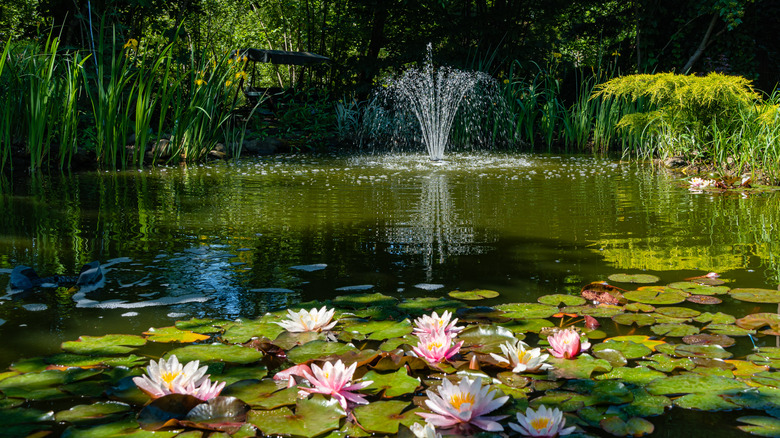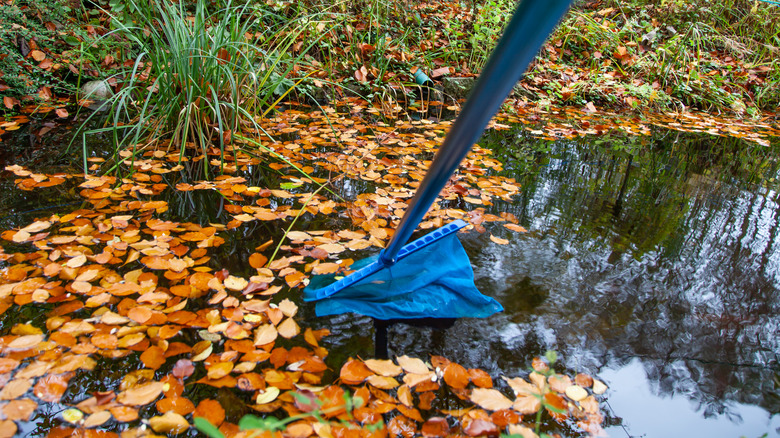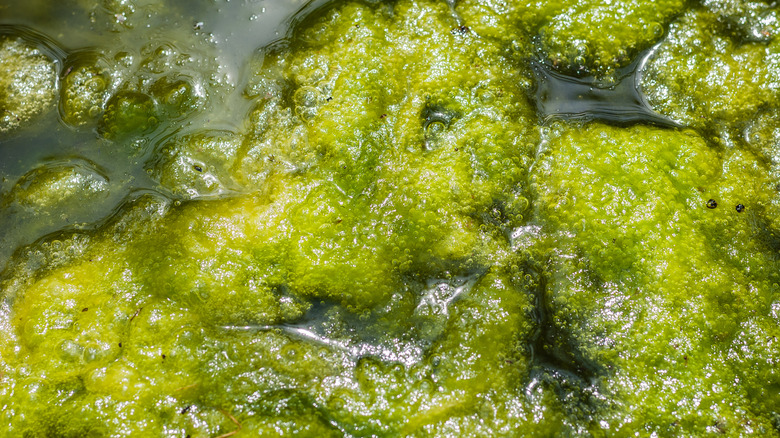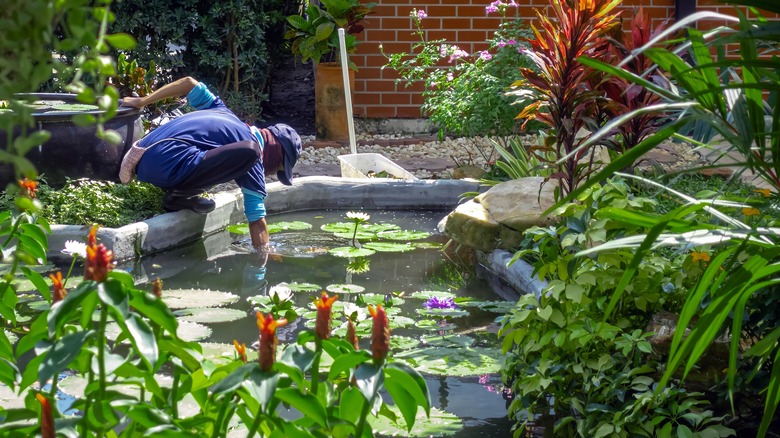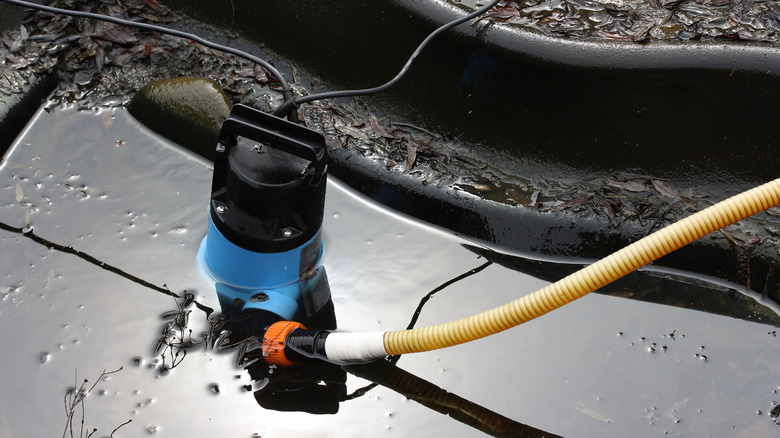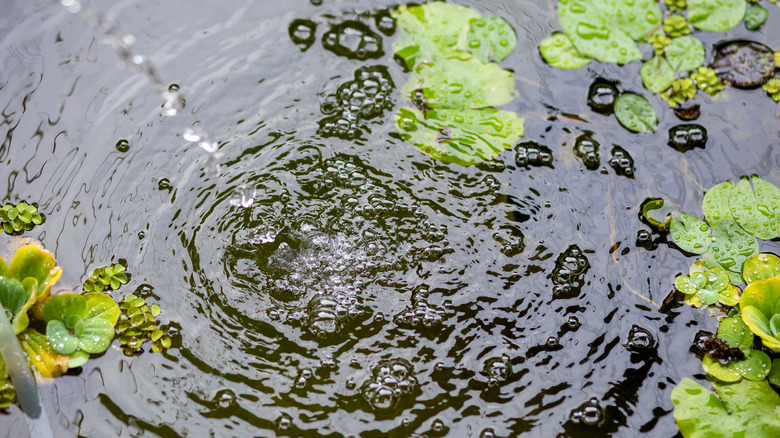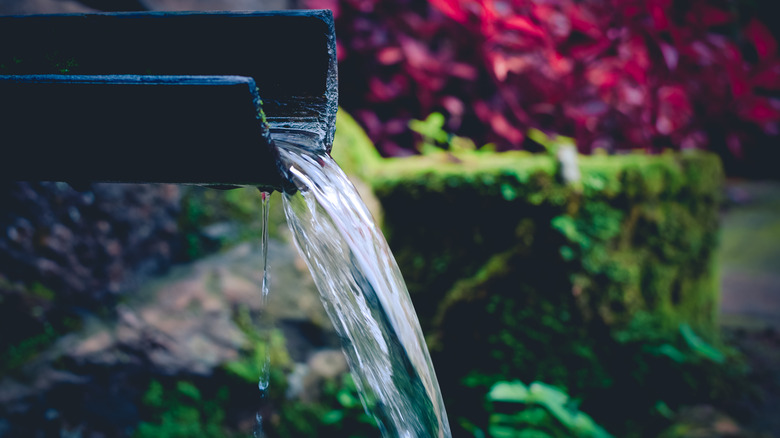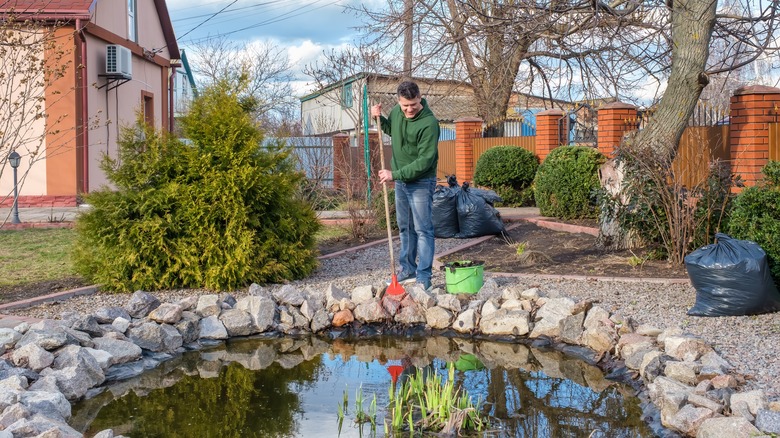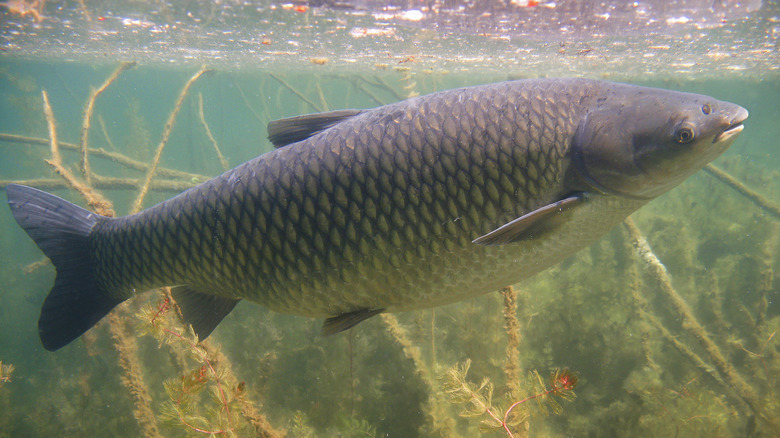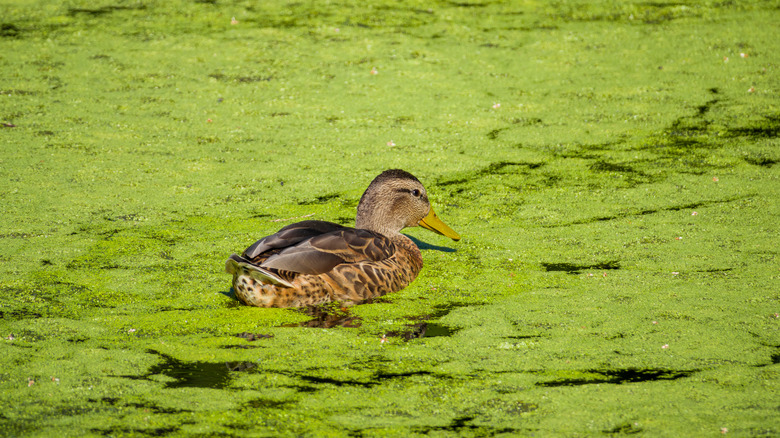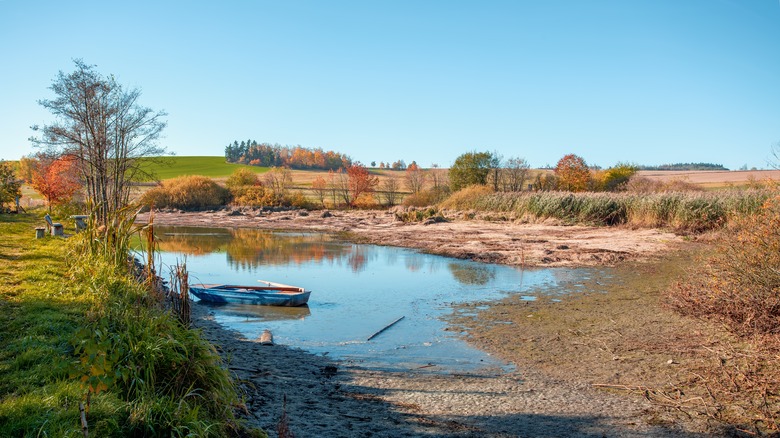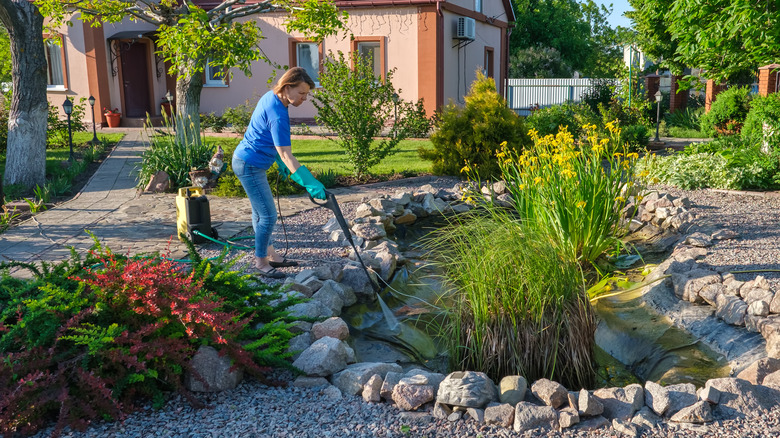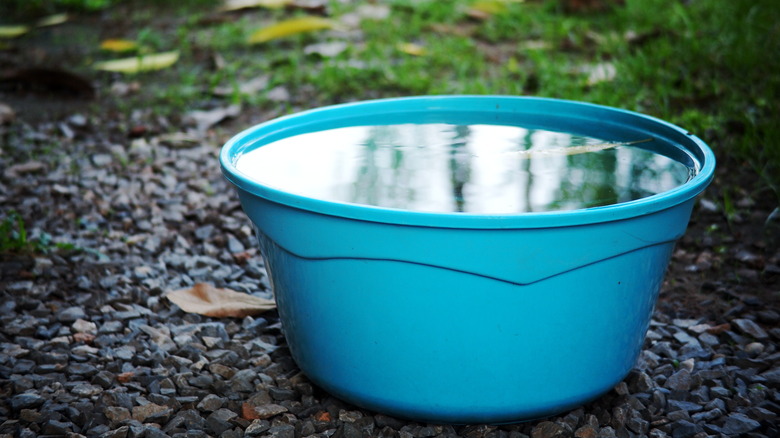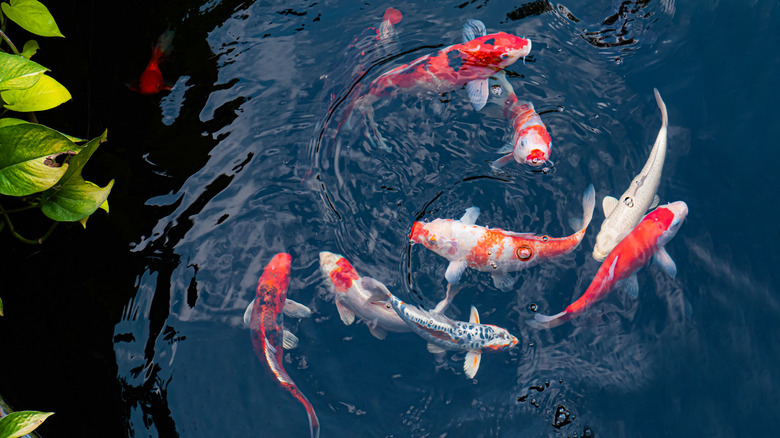How To Go About Cleaning A Garden Pond
We may receive a commission on purchases made from links.
It's probably not unusual for the topic of pond cleaning to be the final straw for anyone thinking about constructing a garden pond. The whole idea is overwhelming and counterintuitive: Since when does anyone clean a pond? What are you going to do, take the water out and scrub it down? Well, yes, but only if you must.
Of course, what we're talking about here are small ornamental ponds you would find in a residential garden, around 150 square feet on average. Velda, a prominent European manufacturer of pond-related products, shares that a typical koi pond measures 11 feet by 16 feet, includes some aquatic plants, sometimes has fish like goldfish or koi, and typically has a liner.
Such a pond is not a closed system, of course, so it interacts with the world. As a result, it gets "dirty" and has to be cleaned from time to time. The things that make you think your pond needs cleaning are often symptoms of the chemical and ecological state of your pond — dark muck on the pond's bottom, an overgrowth of weeds, water green with algae; and in cases where things have gone a bit too far, even an unpleasant odor. We'll tackle all that, but first, let's look at what's happening beneath the surface. If you can make yours a healthy pond, it will require less cleaning in the future, which will make for happier fish, plants, and pond owners.
How do you know when it's necessary to clean a pond?
We instinctively feel that clear water unsullied by the gunk and sediment of natural processes means the pond is clean. But this is practically impossible, and even clear water isn't necessarily a sign of pond health. Usually, in a stocked pond, much of the need for cleaning comes from an excess of waste, either from fish or decomposing vegetable material. This material forms the "muck" at the bottom of the pond, where most of the oxygen is used in a healthy pond to break down this waste. In a less healthy pond, the muck doesn't decompose properly and just continues to build up, according to Pond Place of Michigan. Oxygen, as we will see, is the key to a healthy and perpetually clean pond, and the lack of oxygen is the root of most of a pond's problems.
Excessive algae growth also triggers the need to clean. Excess muck is a key contributor here, too. Aquascape, a major supplier of pond-care goods, attributes excessive algae to an improper balance of nutrients, as well as an imbalance of light and shade.
How do ponds get out of whack to begin with?
The Penn State College of Agricultural Sciences says the optimal pond ecological balance includes a "complete and balanced food web." There are a lot of ways this web can get out of balance. Alongside excess nutrients, insufficient aeration is the other major cause of ecological imbalance in a garden pond. And aeration is one of the major approaches to handling a large nutrient load. The excess of nutrients in the water is often caused by fertilizer runoff, manure, leaves, grass clippings, fish overpopulation, and many others. This material blocks light, which inhibits processes that produce oxygen in the water consumed by algae.
Light is the other key part of the balance equation. In fact, one of the key ways murky water harms your pond is by preventing light from getting where it's needed. Low light penetration reduces the amount of oxygen, creating murkier waters.
It's tempting to think you can simply control some variables (the presence of a shade tree, the fertilizer used on your lawn, the leaves and grass that find their way into the pond) to control light and nutrient load. But what you're confronting isn't just human choices; it's also the natural tendency of systems like pond ecosystems to change. Eutrophication is a natural process and is part of normal pond life, according to Pristine Waters. Eutrophication, the natural buildup of nutrients such as phosphorus and nitrogen, is always at work and must be dealt with.
How much cleaning to do, and when
When it comes to pond maintenance, Good Earth Water Gardens urges gentleness. Clean surfaces lightly, and don't fret about having some algae in the water; it's a necessary component of pond health. It has become a habit of the pond-owning community to talk about this particular aspect of pond maintenance as "spring cleaning," but there's a case to be made for switching that to the fall.
Gardening Know How says to clean plants-only ponds in spring, and ponds with fish in the fall when fish are their strongest and best able to withstand the shock of the process. Aquascape argues that you should clean in spring before water temperatures reach 55 degrees Fahrenheit to minimize disruption of established biological processes later in the season. There is, of course, nothing preventing you from doing it both in spring and fall, but be cautious about the shock this will give to your fish, plants, and the good bacteria that keep everything in balance. Obviously, the less dramatic your cleanings and water replacement, the less shock will occur.
The great debate: to empty or not to empty?
In the fight over whether it's necessary to empty a pond periodically for cleaning, the sides hold unexpected views. The more scientific community seems to focus on the equilibrium that can be achieved by leaving a healthy pond alone, while the landscape-minded gardening community is prone to the more dramatic approach of draining, cleaning, and refilling ponds. Smack in the middle are pragmatic experts like those at Pond Informer, who argue that very limited water replacement in spring and fall is the right approach.
The Pond Place of Michigan recommends a 25% water change unless you have more than 1 inch of muck at the bottom of your pond, in which case you should do a complete water change. A complete water change is very close to starting over. It is a huge strain on your plants and fish, and might even be impossible if you have a large pond.
Dechlorinating the replacement water
No matter how much water you replace, if your water comes from your municipal water supply, you will need to remove either chlorine or chloramine, the two substances that are used to treat drinking water supplies in the U.S. Chlorine and chloramine don't distinguish between harmful bacteria and the bacteria that are necessary to a healthy pond. Neither substance has a place in your pond, as the damage it does to aquatic life is immediate and severe, says SpringWell Water Filtration Systems. Chloramine is more difficult to remove, while chlorine is volatile and will naturally remove itself from water in a fairly short time. Find out if your water is treated with chlorine or chloramine; otherwise, proceed as if your water contains both.
To rid your pond of chlorine, you can use a water conditioner and dechlorinator such as Aquascape's Pond Detoxifier. Another option is to let it sit for a few days. Chlorine is volatile, and most will migrate out of water in 24 to 48 hours (although Fish Tank Master advises that the process can take almost five days to complete). This process can be accelerated with the mechanical aeration of the water. There are filtration systems available that use activated carbon to remove chlorine (and chloramine), and you can simply submerge a mesh bag containing activated carbon in the pond, but these solutions can be slow. Commercial-scale dechlorinators are also available, but are not practical for the average garden pond owner. Always use a chlorine test kit to ensure it has all been removed.
Okay, but what about chloramine?
Chloramine is in water delivered to over 20% of American homes (via the EPA) and is more challenging to deal with because it doesn't evaporate quickly as chlorine does. This leaves you with the chemical fixes of activated carbon and water conditioners/dechlorinators specifically designed to handle chloramine. Keep in mind that removing chlorine and chloramine via activated carbon filtration is a slow process (how slow depends on the type of carbon, the size of your filter, the capacity of your pump, etc.), and so it might not be appropriate for any but the smallest ponds unless you can filter the water before introducing it to the pond.
Pay close attention to the amount of conditioner or activated carbon required to dechlorinate your pond. The popular Pond Guy brand of activated carbon treats 1,000 gallons, about enough for a 6-foot by 8-foot, 3-foot-deep pond, according to Hartz.com, and retails for $80. You might require three times that amount for an average-sized pond. Nualgi Ponds recommends replacement with rainwater. If you can store enough water, this is a good solution that bypasses the dechlorination process altogether.
The tools for making it clean
The tools available for cleaning a pond are numerous, and most are simple enough to require little instruction. They generally involve the mechanical removal of unwanted muck and sediment, as well as the cleaning of surfaces. Most are meant for cleaning lakes and ponds while they are full of water. Tools like long-handled fish nets and fine pond nets help remove floating weeds, leaves, and other debris but are ineffective against bottom muck and rooted weeds. Weed cutters, rollers, and rakes can, alone or in combination, be fairly effective at dealing with weeds and fairly ineffective at managing muck. Think of managing your lawn, but underwater and with only manual tools like a rake and reel mower.
Muck shovels (or mud shovels) are back-breaking and effective, but may be best used in an empty pond mid-water change. If your strength and endurance are less than heroic, a pond vacuum (or water vacuum) might be your best option. They're not great at dealing with weeds, but are effective at cleaning out the muck. Muck blowers and lake groomers move muck and weeds around and are the underwater equivalent of blowing your leaves onto someone else's lawn. As you might imagine, these tools aren't helpful for small garden ponds.
The tools for keeping it clean
Some mechanical cleaning will always be necessary with an immature pond or a pond that is even slightly out of balance. But once you rule out drastic water replacement, almost everything you do to make your pond healthier becomes a cleaning method of sorts. Filtration is one key approach. This broad category includes mechanical, biological, and UV (clarifying) filters, often combined with each other, per Envii Pond Klear. Mechanical filters like waterfall and canister filters are important components that take our debris in bulk and reduce the load on your biofilters. Biofilters include everything from bioballs to naturally filtering plants, like hornwort, soft rush, water lilies, and cattails (via Pond Informer). UV Clarifiers are often combined with canisters and other filters, and are effective at clarifying water by killing algae. Note that they do not remove algae, so effective clarification of water requires mechanical filtration as well.
Chemical alterations are another broad category of pond maintenance methods. This can include aeration, which can be facilitated by wind, waterfall or flowing water features, or mechanical aeration devices. Additives like gypsum can be used to clarify water. If you have low water hardness and an issue with clouding by suspended clay particles, gypsum might help. It's commonly understood that gypsum, being neutral, will neither raise nor lower the pH of water or soil, but there have been studies that show gypsum to have a mild effect on pH (via Soil Science Society of America). Epsom salts, alum, and limestone can similarly clarify turbid water, but these have a strong effect on water pH that might not be desirable (via Texas AgriLife Extension).
Grass carp are used as a biological control mechanism to manage aquatic plant overabundance, according to the University of Florida. They naturally prefer problem plants like hydrilla and pondweed over cultivated plants like water lily and cattails. Just note that they can reduce water clarity while shifting available nutrients from plants to phytoplankton in the pond. You can acquire triploid (non-reproducing) grass carp with a permit in many states.
Keeping algae in check
Anyone who has dealt with an aquarium, a pool, rainwater storage, or a water feature probably knows the struggle of contending with algae. And the ecological sensitivity of a typical pond rules out some of the more immediately effective and harsher options. Pond Informer suggests using barley straw or barley extract as a preventive or a maintenance method for managing algae after an initial treatment (often with a UV clarifier). Barley straw won't address an existing algae problem with a low dissolved oxygen level. Barley extract is the quicker and more dramatic of the two, but it can harm fish if not used in a controlled fashion, so it's better to use the straw.
UV clarification, discussed above, is very effective against planktonic algae. Competing plant species like hornwort can reduce algae, as can algae-eating fish species such as common and bottlenose pleco, Siamese algae eaters, pond loach, grass carp, and some aquarium species. Algaecides such as copper sulfate, Cutrine Plus, and Green Clean are effective and involve varying degrees of potential toxicity. Naturally occurring microbes that minimize muck are also helpful, per Healthy Ponds. Aeration can help by making sure nutrients are used efficiently and are not available to algae, and can also buffer against an algae die-off, according to Kasco Marine.
How to drain a pond
In most cases, you would drain a pond by the simple expedient of a pump of one sort or another. A small pond or a slow drain would only require a slow method like siphoning, manual pumping, or perhaps a solar-powered pump, says Pond Academy. Electric submersible pumps are a good choice for draining moderately sized ponds, as are vacuum systems that also feature drain capabilities. For larger ponds, high-volume gas-powered pumps with 2-inch inlet and discharge hoses (or larger) might be called for. We'll assume a higher-volume pump, but note that a slower pump might really draw out some of these processes.
Start with some maintenance. The more leaves, muck, weeds, and debris you can move, the less your pump will have to deal with, and the less time your fish will spend out of their pond. Drain the water using the pump of your choice. If you have fish, start by filling the tank you will use to temporarily house your fish while you clean. Keep them in the shade, and don't keep them in your temporary tank for more than a few hours, Aquascape warns. Early in the process, try to pump this water from the surface of your pond, not from the mucky bottom. Discharge the water into your garden, lawn, or landscape to make use of nutrients suspended in it. As the water level drops, move the pump's inlet to the deepest area of the pond.
The pond-cleaning process
With all this in mind, how do you go about the annual (or semi-annual) cleaning of a garden pond? It's simpler than you might have guessed. Drain the pond no more than halfway unless you are experiencing rather extreme muck, odor, or algae issues, according to Pond Academy. As the water gets close to your target level, remove fish to a temporary holding tank.
If you are doing a complete or near-complete water change, leave the pump, discharge, and inlet (if applicable) hoses in place. Rinse the exposed rocks, liner, etc. by washing them with a garden hose sprayer or pressure washer. Advice varies on the amount of water pressure to use, but if you're not experiencing particularly severe issues, a light cleaning is best as it leaves more beneficial bacteria and insects in your pond area. If you are doing a complete or near-complete water change, periodically turn on your pump to drain away the dirty water introduced when rinsing. Clean your filter mechanisms and replace any consumables, such as activated carbon. Refill with dechlorinated water, or fill the pond and condition the water in place.
Reintroducing and acclimating fish to new pond water
After draining and refilling your pond, the task of reintroducing any removed fish becomes your priority, and it can be a delicate process. New pond syndrome is a common set of issues with newly filled ponds, according to Nualgi Ponds, and these can also be introduced via a substantial water change. While experts might recommend a slow process for setting up a pond and coping with new pond syndrome, you don't have that luxury with fish that have been temporarily removed.
First, this is not the time to add new fish to your pond. According to Hoffman's Water X Scapes, beneficial nitrifying bacteria will take four to six weeks before existing in numbers to handle the fish waste. Work as quickly as you can once the fish are removed so that acclimating them to the new water isn't adding huge stress to huge stress. Finally, work in the shade, and if you don't have shade, find a way to create some. Water can easily overheat in small containers when exposed to direct sunlight.
Now, if your temporary holding containers (let's call them "tubs") will float, which is ideal, put them in your pond and add pond water to the tub, perhaps ⅓ of the volume of water in the tub already. Add a small amount every five to 10 minutes for no more than an hour before gently releasing the fish. Being gradual is key; your goal is to equalize the temperature between the pond and the tub and get the fish used to the properties of the pond before being immersed in it.
Where to get help with your pond
In the internet age, no one goes long in desperate need of advice, but getting reliable advice is another matter altogether. You can certainly find good information online, such as some of the ones mentioned here, and online forums can also be great resources. Pond Boss and Garden Pond Forum are two active and reputable sites.
Your local cooperative extension service can also be a fantastic source of help. Some extension services offer direct consultation and even on-site services, usually for a fee. Consultants often provide these, and you can always locate and hire consultants after a quick Google search. For example, the Alabama Cooperative Extension offers fish population balance checks, fish kill investigations, and expert guidance on weed control. You might find that some extension services like the UGA Cooperative Extension are focused on agriculture-scale ponds, while others have a large number of resources for residential pond owners, like these Clemson Cooperative Extension factsheets and articles. They should all prove helpful to you.
Suppose your county or municipality requires permitting and inspections for ponds. In that case, you can always try to pump the inspector for advice, though this will likely be more successful if you are in the midst of the permitting process.
